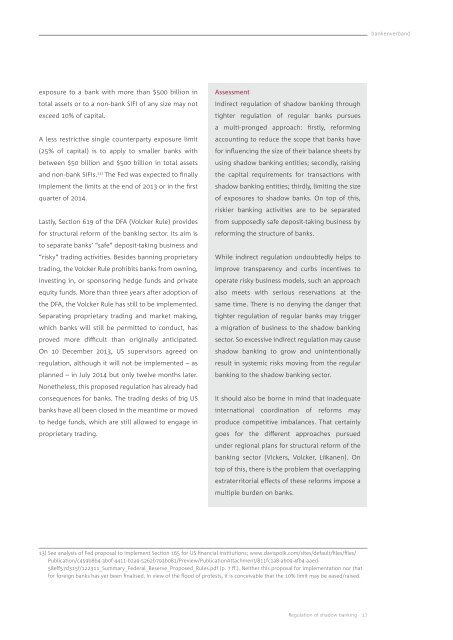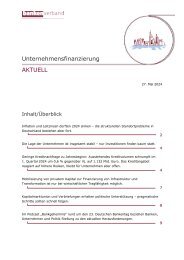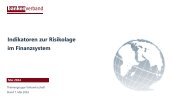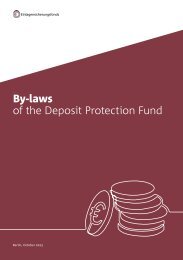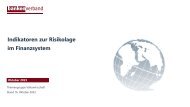Regulation of shadow banking
Shadow banking is given a large share of the blame for the financial crisis. This perception raises the question of what kind of shadow banking system should remain in place in the future.
Shadow banking is given a large share of the blame for the financial crisis. This perception raises the question of what kind of shadow banking system should remain in place in the future.
You also want an ePaper? Increase the reach of your titles
YUMPU automatically turns print PDFs into web optimized ePapers that Google loves.
ankenverband<br />
exposure to a bank with more than $500 billion in<br />
total assets or to a non-bank SIFI <strong>of</strong> any size may not<br />
exceed 10% <strong>of</strong> capital.<br />
A less restrictive single counterparty exposure limit<br />
(25% <strong>of</strong> capital) is to apply to smaller banks with<br />
between $50 billion and $500 billion in total assets<br />
and non-bank SIFIs. 13) The Fed was expected to finally<br />
implement the limits at the end <strong>of</strong> 2013 or in the first<br />
quarter <strong>of</strong> 2014.<br />
Lastly, Section 619 <strong>of</strong> the DFA (Volcker Rule) provides<br />
for structural reform <strong>of</strong> the <strong>banking</strong> sector. Its aim is<br />
to separate banks’ “safe” deposit-taking business and<br />
“risky” trading activities. Besides banning proprietary<br />
trading, the Volcker Rule prohibits banks from owning,<br />
investing in, or sponsoring hedge funds and private<br />
equity funds. More than three years after adoption <strong>of</strong><br />
the DFA, the Volcker Rule has still to be implemented.<br />
Separating proprietary trading and market making,<br />
which banks will still be permitted to conduct, has<br />
proved more difficult than originally anticipated.<br />
On 10 December 2013, US supervisors agreed on<br />
regulation, although it will not be implemented – as<br />
planned – in July 2014 but only twelve months later.<br />
Nonetheless, this proposed regulation has already had<br />
consequences for banks. The trading desks <strong>of</strong> big US<br />
banks have all been closed in the meantime or moved<br />
to hedge funds, which are still allowed to engage in<br />
proprietary trading.<br />
Assessment<br />
Indirect regulation <strong>of</strong> <strong>shadow</strong> <strong>banking</strong> through<br />
tighter regulation <strong>of</strong> regular banks pursues<br />
a multi-pronged approach: firstly, reforming<br />
accounting to reduce the scope that banks have<br />
for influencing the size <strong>of</strong> their balance sheets by<br />
using <strong>shadow</strong> <strong>banking</strong> entities; secondly, raising<br />
the capital requirements for transactions with<br />
<strong>shadow</strong> <strong>banking</strong> entities; thirdly, limiting the size<br />
<strong>of</strong> exposures to <strong>shadow</strong> banks. On top <strong>of</strong> this,<br />
riskier <strong>banking</strong> activities are to be separated<br />
from supposedly safe deposit-taking business by<br />
reforming the structure <strong>of</strong> banks.<br />
While indirect regulation undoubtedly helps to<br />
improve transparency and curbs incentives to<br />
operate risky business models, such an approach<br />
also meets with serious reservations at the<br />
same time. There is no denying the danger that<br />
tighter regulation <strong>of</strong> regular banks may trigger<br />
a migration <strong>of</strong> business to the <strong>shadow</strong> <strong>banking</strong><br />
sector. So excessive indirect regulation may cause<br />
<strong>shadow</strong> <strong>banking</strong> to grow and unintentionally<br />
result in systemic risks moving from the regular<br />
<strong>banking</strong> to the <strong>shadow</strong> <strong>banking</strong> sector.<br />
It should also be borne in mind that inadequate<br />
international coordination <strong>of</strong> reforms may<br />
produce competitive imbalances. That certainly<br />
goes for the different approaches pursued<br />
under regional plans for structural reform <strong>of</strong> the<br />
<strong>banking</strong> sector (Vickers, Volcker, Liikanen). On<br />
top <strong>of</strong> this, there is the problem that overlapping<br />
extraterritorial effects <strong>of</strong> these reforms impose a<br />
multiple burden on banks.<br />
13) See analysis <strong>of</strong> Fed proposal to implement Section 165 for US financial institutions; www.davispolk.com/sites/default/files/files/<br />
Publication/c459b8b4-3b0f-4411-b2a9-5262b793b081/Preview/PublicationAttachment/811fc1a8-ab09-4fb4-aaed-<br />
58eff57d315f/122311_Summary_Federal_Reserve_Proposed_Rules.pdf (p. 7 ff.). Neither this proposal for implementation nor that<br />
for foreign banks has yet been finalised. In view <strong>of</strong> the flood <strong>of</strong> protests, it is conceivable that the 10% limit may be eased/raised.<br />
<strong>Regulation</strong> <strong>of</strong> <strong>shadow</strong> <strong>banking</strong> 17


